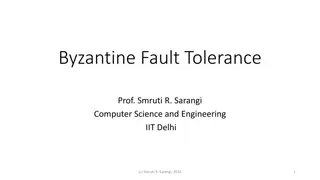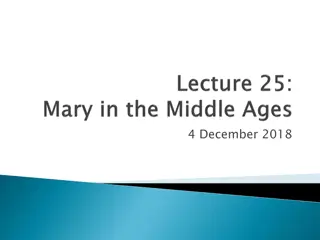Byzantine Empire and Eastern Orthodox Church Overview
The Byzantine Empire, also known as the Eastern Roman Empire, flourished from 330 CE to 1453 CE under Greek rule. It played a significant role in trade, politics, and culture during the Post-Classical Era, connecting trade routes and reconquering the West under rulers like Justinian. However, challenges such as plagues, rebellions, and invasions led to its decline. The Eastern Orthodox Church, splitting from the Roman Catholic Church in 1054, established its own hierarchy and spread through Eastern Europe, converting various peoples.
Download Presentation

Please find below an Image/Link to download the presentation.
The content on the website is provided AS IS for your information and personal use only. It may not be sold, licensed, or shared on other websites without obtaining consent from the author.If you encounter any issues during the download, it is possible that the publisher has removed the file from their server.
You are allowed to download the files provided on this website for personal or commercial use, subject to the condition that they are used lawfully. All files are the property of their respective owners.
The content on the website is provided AS IS for your information and personal use only. It may not be sold, licensed, or shared on other websites without obtaining consent from the author.
E N D
Presentation Transcript
Byzantine Empire Eastern Roman Empire
Byzantine Empire (330 CE-1453 CE) The Eastern Empire split from Rome after 330 CE, and continued under Greek rule While the West fell in 485 CE, the East continued and was a dominant force In economics, politics, trade, and culture throughout the P-C Era Throughout the Post-Classical Era, the Byzantine Empire would connect The trade routes of the MSTN to the East through the Silk Road in Antioch At its height, Justinian (527-565) and Theodora reconquerd the West However, plagues, like the Black Death (14thcentury), rebellions (Basil the Copperhand), and invasions (Arabs and Turks) would lead to its decline in 1453
Eastern Orthodox Church 1054 CE to Present United with the pope in Rome, religious differences causes the Great Schism in 1054, starting the Eastern Orthodox Church in Constantinople This split in Christendom established the Roman Catholic Church and the Eastern Orthodox Church separately, and as enemies However, the Patriarch of Constantinople was setup as the equivalent of the pope in Rome and gave legitimacy to the emperor by anointing him (constructed Hagio Sophia) Religious hierarchy was similar to the Church in Rome, with bishops and priests heading churches and convents throughout From here, missionaries (Cyril and Methodius) spread throughout eastern Europe, and converted the Kievan Rus and other Slavic peoples
Byzantine Domestic Policies and Issues Initially, caesaropapism the gave the emperor both political and religious power as head of both the state and the church However, it soon became clear that having a moral religious leader and political leader were impossible, as well as the presence of laws that were Christian-focused in nature As a result, law became a civil (purely state, and not religious) subject under the Byzantines Common laws were formed that applied to all citizens, and attempted to be treated as fair rules and regulations for human beings, rather than simply a way for rulers to exert power Code of Justinian was established as the form of common law throughout the empire, & marked the beginning of a unified civil law (with juries, judges, etc.) that cont. in the West























